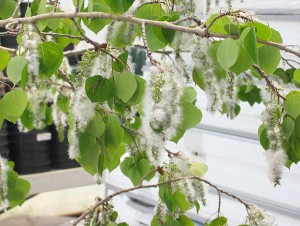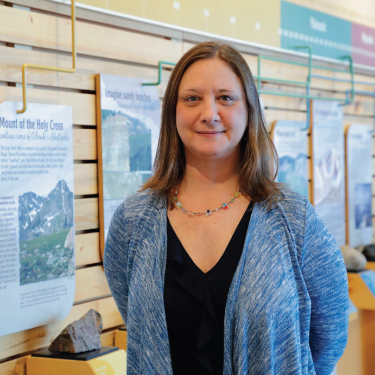 Look! Up in the sky! It’s a bird, it’s a plane, no, it’s a catkin! A what? Yes, the catkins are coming, but what are they? Think you’ve never seen a catkin? You’re probably wrong. That’s because they look a lot more like fuzzy little caterpillars growing on the trees than flowers. You’ve probably seen them dangling from the aspens or cottonwoods in your neighborhood and later, when they go to seed and spread their fuzziness throughout the land and air, you can’t help but notice them. Why do these flowers look so strange to us? Where are the glossy petals and fragrant smells?
Look! Up in the sky! It’s a bird, it’s a plane, no, it’s a catkin! A what? Yes, the catkins are coming, but what are they? Think you’ve never seen a catkin? You’re probably wrong. That’s because they look a lot more like fuzzy little caterpillars growing on the trees than flowers. You’ve probably seen them dangling from the aspens or cottonwoods in your neighborhood and later, when they go to seed and spread their fuzziness throughout the land and air, you can’t help but notice them. Why do these flowers look so strange to us? Where are the glossy petals and fragrant smells?
Catkins are our first spring flowers, gracing the bare aspen and cottonwood tree branches even before the first green leaves appear. They don’t have the glamour and beauty (or even the petals) associated with their showier cousins, but they are important early food sources for many species, and they do have a unique beauty all their own, if you just know how to appreciate it.
The fragrance and splendor of flowers is something we often take for granted. We pay homage to the brightest and the most beautiful among them, gathering them as signs of love and friendship. But flower petals are actually a fairly recent evolutionary innovation, and the petal-less catkin, one of our earliest flowers, evolved before the onslaught of insects in our planet’s prehistoric past. Without the need to attract insects for pollination, there was no reason to invest energy into the production of colors or fragrances. These flowers, instead, depend upon the wind for fertilization and seed dispersal.
The classic catkin-growing trees that we see locally are the poplar family trees – aspens, cottonwoods, willows, and alders. I think everyone recognizes the aspens, with their silvery white bark and famous show of golden colors in the fall. And most will also recognize the clusters of trees and shrubs lining the edges of our rivers as shrubby willows with their slender, flexible stems, surrounded by their tall, stately cousins, the cottonwoods. But here’s my challenge for you. Find an alder tree. Don’t wait, because right now is the perfect time. Right about now, in most places, the alder trees are way ahead of the flowering game and most are full of fat, juicy, caterpillars – I mean catkins.
Maybe I’m biased, but the alder trees are really one of the jewels of our riverbanks. Sturdy hardwoods with an intricate root system that help to hold precious soil in place, these trees are worth a second look. I won’t belabor you with a detailed description of the bark, since we’re talking about catkins, but its striking gray color with the slight purple sheen to it really stands out. But back to the catkins … there are two types, actually, the male and the female. On the alder, the longer male catkins look like a series of flat puzzle pieces neatly fit together to create the long, caterpillar shape. These catkins disperse the pollen, which float on the wind to pollinate the smaller, female catkins. The female catkins are shaped more like a ball, and actually resemble miniature pine cones if you look closely. It is in these tiny, intricate shapes that we begin to appreciate the beauty and uniqueness of this special tree.
So don’t forget about my challenge – can you find an alder tree? Post on our Facebook page and tell us all about it! Where were you? Did you find the catkins? Did you shake apart the delicate male caterpillars and watch the symmetrical flakes flutter to the ground? Did you pluck off a tiny female “cone” and blow it’s miniscule seeds to the wind?
It takes all kinds of people to make the world go round, and it also takes all kinds of plants. Not all flowers are bold and colorful; but they all have their own kind of beauty, just like all kinds of people.
Jaymee Squires is the Director of Graduate Programs at Walking Mountains Science Center in Avon. She has been reveling in the appearance of the alder catkins on campus lately and hopes they will delight you too.









